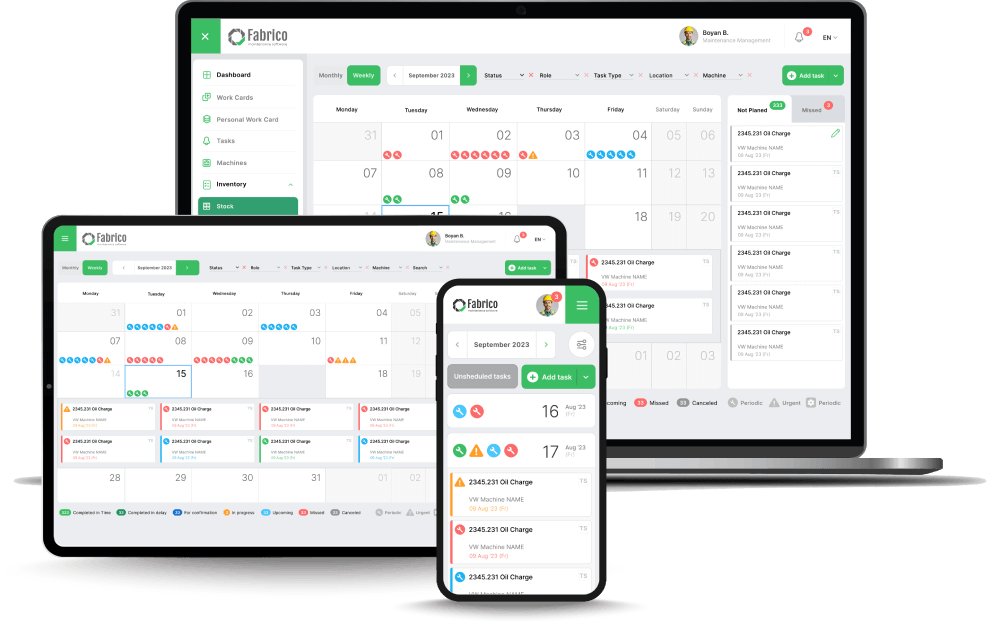Systems that handle work order management and work order tracking are equipped with a wide variety of features. Among the most common ones are the following:
Work order scheduling
Every plant manager in a manufacturing facility knows the importance of preventive maintenance. It prevents and minimises downtime, and it ensures expensive machines do not require frequent and costly repairs.
This type of maintenance is proactive in nature and requires work to be done on a machine before it breaks down. In such cases, an accurate maintenance schedule for work orders is a must.
However, keeping track of multiple machines and their maintenance requirements can be a challenging task. Plant managers can easily schedule preventive maintenance tasks and work orders by assigning them to their teams through this software.
They can do this in an automated way and team members will immediately be notified of the work order. In addition, it can help them stay on schedule and anticipate the next task, whether they are on the floor or in another facility at a different location.
Work order management
Managing maintenance work orders is akin to a juggling act. A plant manager needs to keep an eye on multiple tasks simultaneously, track work and ensure each one is executed properly within the allotted time.
Through such a system, they can create a calendar to indicate what maintenance work needs to be done, when and by whom. In addition, this scheduling contains a single dashboard through which to view all tasks in the pipeline.
Managing work orders therefore becomes easier because managers know who is working on what at any given moment. This gives them a quick bird’s eye view of all work requests as well as an optimal distribution of human resources and teams.
Furthermore, it’s also possible to monitor inventory and spare parts levels to ensure that the task is carried out without interruptions to the process flow.
Work cards
Every team member on your maintenance team needs to know exactly what they will be working on and when.
With a work order system, managers can issue digital work cards to assist them. These work cards specify the machine to be worked on, when maintenance should be done and more.
Once the maintenance task is completed, the team member can fill in the work card and send it back to the manager. Work cards can be signed off as complete and they also provide a history of the work done. This aids in building a knowledge base for other team members who will work on the same machine in the future.
Further to this, work cards can be collected and centralised for analysis and reporting purposes. As such, they play a key role in strategising for the future benefit of the organisation. Specifically, strategising can be done as part of the management process based on the time taken to complete a maintenance task and what parts were used in relation to maintenance costs.
Assigning work tasks
Preventive maintenance teams comprise professionals who can ensure that a machine is maintained properly at the right time. Different machines may require a different set of expertise.
When a plant manager assigns a task through the system, they need to be aware of the team member’s availability and skill set to ensure that no faults arise. A task system facilitates this process because its dashboard enables managers to see who is available and whether they are suited for the task.
Additionally, they can schedule recurring and periodic tasks in advance so that the right team member knows what to work on. This keeps teams organised at maximum efficiency for the ultimate purpose of reducing machine downtime and preventing larger, costlier and more complex breakdowns.
Inventory control
Inventory management is an indispensable part of work order management. But if your organisation is still doing inventory control manually, you may have realised that it’s costing you a lot of time and resources.
When you choose a centralised system, you will have your list of inventory available at a glance through a dashboard. Controlling what stock leaves and enters your storeroom, as well as which of your machines are and aren’t in working order, is an important step to take.
When your inventory list is imported into a CMMS, it can be managed much more efficiently. With this system, you can also help your team speed up maintenance activities as opposed to waiting for spare parts to arrive, leaving everyone involved idle.
Through a centralised system, your tasks are automatically aligned with your inventory which means you can introduce greater efficiencies in your processes.
Work order notifications
Another advantage is that every relevant party is connected through a mobile work order. Every time there is an update on the system, these individuals receive a notification in real time for better work order processing and tracking.
When this is the case, task management becomes much faster and more efficient because everyone knows what to do at any given moment through clear maintenance requests. Facility and plant managers can track maintenance as well as receive up-to-date data about the completion of tasks. They will also know who is responsible for the latter and what spare parts are needed and will be taken out of inventory. Additionally, they will get instant information about which machine is going to be worked on, how long the maintenance process took to complete and so much more.
Also available through this system are work history, invoices and other information related to the particular work order to streamline maintenance and maintenance programs.











